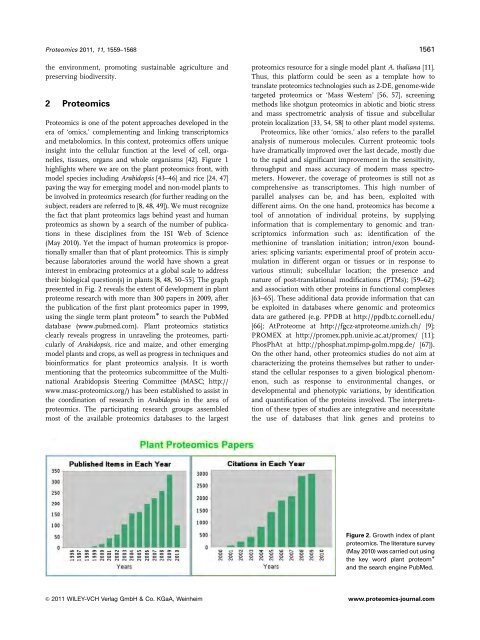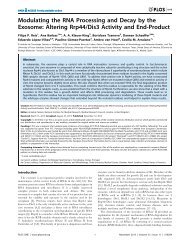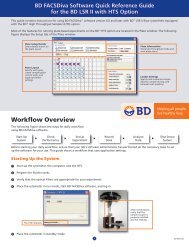<strong>Proteomics</strong> 2011, 11, 1559–1568 1561the environment, promoting sustainable agriculture andpreserving biodiversity.2 <strong>Proteomics</strong><strong>Proteomics</strong> is one of the potent approaches developed in theera of ‘omics,’ complementing and linking transcriptomicsand metabolomics. In this context, proteomics offers uniqueinsight into the cellular function at the level of cell, organelles,tissues, organs and whole organisms [42]. Figure 1highlights where we are on the plant proteomics front, withmodel species including Arabidopsis [43–46] and rice [24, 47]paving the way for emerging model and non-model plants tobe involved in proteomics research (for further reading on thesubject, readers are referred to [8, 48, 49]). We must recognizethe fact that plant proteomics lags behind yeast and humanproteomics as shown by a search of the number of publicationsin these disciplines from the ISI Web of Science(May 2010). Yet the impact of human proteomics is proportionallysmaller than that of plant proteomics. This is simplybecause laboratories around the world have shown a greatinterest in embracing proteomics at a global scale to addresstheir biological question(s) in plants [8, 48, 50–55]. The graphpresented in Fig. 2 reveals the extent of development in plantproteome research with more than 300 papers in 2009, afterthe publication of the first plant proteomics paper in 1999,using the single term plant proteom to search the PubMeddatabase (www.pubmed.com). Plant proteomics statisticsclearly reveals progress in unraveling the proteomes, particularlyof Arabidopsis, rice and maize, and other emergingmodel plants and crops, as well as progress in techniques andbioinformatics for plant proteomics analysis. It is worthmentioning that the proteomics subcommittee of the MultinationalArabidopsis Steering Committee (MASC; http://www.masc-proteomics.org/) has been established to assist inthe coordination of research in Arabidopsis in the area ofproteomics. The participating research groups assembledmost of the available proteomics databases to the largestproteomics resource for a single model plant A. thaliana [11].Thus, this platform could be seen as a template how totranslate proteomics technologies such as 2-DE, genome-widetargeted proteomics or ‘Mass Western’ [56, 57], screeningmethods like shotgun proteomics in abiotic and biotic stressand mass spectrometric analysis of tissue and subcellularprotein localization [33, 54, 58] to other plant model systems.<strong>Proteomics</strong>, like other ‘omics,’ also refers to the parallelanalysis of numerous molecules. Current proteomic toolshave dramatically improved over the last decade, mostly dueto the rapid and significant improvement in the sensitivity,throughput and mass accuracy of modern mass spectrometers.However, the coverage of proteomes is still not ascomprehensive as transcriptomes. This high number ofparallel analyses can be, and has been, exploited withdifferent aims. On the one hand, proteomics has become atool of annotation of individual proteins, by supplyinginformation that is complementary to genomic and transcriptomicsinformation such as: identification of themethionine of translation initiation; intron/exon boundaries;splicing variants; experimental proof of protein accumulationin different organ or tissues or in response tovarious stimuli; subcellular location; the presence andnature of post-translational modifications (PTMs); [59–62];and association with other proteins in functional complexes[63–65]. These additional data provide information that canbe exploited in databases where genomic and proteomicsdata are gathered (e.g. PPDB at http://ppdb.tc.cornell.edu/[66]; AtProteome at http://fgcz-atproteome.unizh.ch/ [9];PROMEX at http://promex.pph.univie.ac.at/promex/ [11];PhosPhAt at http://phosphat.mpimp-golm.mpg.de/ [67]).On the other hand, other proteomics studies do not aim atcharacterizing the proteins themselves but rather to understandthe cellular responses to a given biological phenomenon,such as response to environmental changes, ordevelopmental and phenotypic variations, by identificationand quantification of the proteins involved. The interpretationof these types of studies are integrative and necessitatethe use of databases that link genes and proteins toFigure 2. Growth index of plantproteomics. The literature survey(May 2010) was carried out usingthe key word plant proteom and the search engine PubMed.& 2011 WILEY-VCH Verlag GmbH & Co. KGaA, Weinheimwww.proteomics-journal.com
1562 G. K. Agrawal et al. <strong>Proteomics</strong> 2011, 11, 1559–1568functions and pathways (e.g. databases based on Geneontologies, MAPMAN and PPDB) [68–70], and wouldbenefit from links with transcriptome and metabolome data.It is worthwhile noting that proteomics can be instrumentalin linking quantitative genetics and physiology, in particularby mapping PQLs (protein QTLs (quantitative trait loci),[71–73]). While eQTLs (expression QTLs) have been detectedby using transcriptome microarrays, the link with metabolismis relatively loose, partly because of PTMs, includingthose involved in protein turn over. Metabolomics profilingprovides very interesting phenotypic data and metaboliteQTLs can be mapped [74]. The integration of metabolomicswith transcriptomics and proteomics is another innovativeway to assign gene functions within a genome and analyzeplant responses at a systems level [33, 75].As proteins are the final products of genes, they potentiallyaccount better than transcripts for activity variationssimply because: (i) their accumulation level is the result of acombination of transcription, translation and protein turnover,and (ii) proteomics studies can also analyze PTMs thatmodulate their activity. All causes of these variations canpotentially be studied, from genes regulating transcriptionto enzymes responsible for PTMs. PTMs affect enzymeactivity and subcellular localization, participate in signaling(e.g. phosphorylation) and play important roles in thematuration of storage proteins. Most of these phenomenacannot be predicted from genome or transcriptome data. Afeature of most plants living in temperate climates is theirreliance on dehydrated stages including seeds [76] andpollen grains [77, 78], where the regulation of mRNA andprotein abundances are particularly disconnected and wherePTMs play an important role.The throughput of proteomics studies is still lower thanthat of transcriptomics studies regarding the number ofgenes and proteins analyzed. The number of proteins thatcan be identified and quantified in a single shotgun MS/MSbasedproteomics experiment using current technology istypically from 500 to several thousands at maximum. Incontrast, tens of thousands of predicted transcripts of anorganism can be analyzed in one experiment (microarrays,SAGE or new generation RNA sequencing), includingquantification of transcript expression levels. However,because cellular reactions directly depend on their amountand state, the analysis of protein variation is potentiallymore informative than the analysis of transcript abundancesfor the analysis of the determinism of quantitative traits.Experimental designs for this type of analysis comprisenumerous genotypes (e.g. populations of recombinantinbred lines). Although up to 200–300 2-D gels can inprinciple be analyzed in the same experiment (e.g. [71, 79]),this is not practical for most laboratories due to the highcosts of materials and labor, and complex tracking andimage analysis. Advances in MS [2], and particularly in labelfreequantification, have made possible the analysis of verylarge data sets in complex multi-variate experimentaldesigns [33, 80]. These approaches will allow the detection ofprotein QTLs and the quantification of candidate proteins inlarge panels for association genetics, enabling new ‘associationproteomics’ programs in plants. Last but not least,continuous progress in sub-cellular identification of proteinsallows pushing the limits toward a detailed understandingof plant proteomes at the sub-organelle, organelle, cell,tissue and organ levels [58, 81].3 The rationale and birth of InternationalPlant <strong>Proteomics</strong> Organization (INPPO)Nevertheless, there is something lacking in our questtoward the ambitious goal of achieving complete understandingof proteomes of plant species. There are manyreasons that can be proposed to explain this gap in ourknowledge. To suggest a few, there is lack of access toproteomics in most plant laboratories around the world, lackof information, lack of close cooperation among proteomicsresearchers and most importantly lack of a suitable platformto globally discuss plant proteomics from both fundamentaland applied perspectives. In addition, there is a morepressing concern that remains to be addressed, which is theincredibly large diversity of plants and crops on our planet,which means different things to different people andsocieties.Only a very few plants are the subject of intensiveresearch efforts, the vast majority are not. For example,Arabidopsis [82, 83] is studied as a model plant largelybecause it was the first plant to be sequenced, has wellestablishedgene manipulation techniques [84], a quick lifecycle and is very easy to handle. Rice, on the other hand, hasa relatively long life cycle, and is difficult to handle, but isbeing investigated as a model for cereal monocot crops(such as wheat, rye, barley and maize), largely because it isthe primary food source of half the world’s population.Oilseeds, other than providing a rich source of energy in ourfood, are being economically exploited as bio-fuel producers.The same holds true for sugarcane and sugarbeet for thesugar they provide us, grapes for wine production andcotton in textile industries. Poplar has been used as themodel plant for woody species [85], for economic and ecophysiologicalreasons, as e.g. it has a wide distribution in thenorthern hemisphere, and hence can be transformed andeasily in vitro propagated. The poplar model has been usedin many studies to provide data on the effects of environmentalstressors in woody plans, and to investigate featuresspecific to woody species, i.e. formation of secondary tissues,overwintering, etc. [86]. Figure 3 highlights some of themajor plants/crops in the world along with their geographicaldistribution. Looking globally, one thing stands out –‘global impact of global plant proteomics.’ In other words,the importance of proteomics in the biological context, plantdiversity and the essential contribution of that biodiversity tothe socio-economic fabric of humankind is beyond anydoubt. Although we would like to claim that proteomics of& 2011 WILEY-VCH Verlag GmbH & Co. KGaA, Weinheimwww.proteomics-journal.com

















